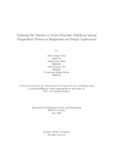Exploring the barriers to access feminine healthcare among marginalized women in Bangladesh and design implications
Abstract
In today’s era of information and technology for promoting and maintaining both
physical and mental health, high-quality healthcare services are crucial. Telecommu-
nications service creates an opportunity to close the digital gap between marginal-
ized women and mobile healthcare services. In a developing country like Bangladesh,
people here still face deprivation of fundamental necessities. Individuals from low-
income backgrounds typically cannot access private healthcare systems due to their
financial constraints. Moreover, due to a lack of knowledge, they are unable to
avail many public healthcare services as well. In Bangladesh, the healthcare system
is financed by the supply side, allowing low-income households to receive medical
treatments or at least basic healthcare. Also, in this study, we acknowledged under-
privileged women are less aware of their physical as well as mental health. Even if
they are aware, individuals may not receive medical aid or correct treatment due to
a lack of basic medical assistance access. Besides, women have distinct healthcare
difficulties than men, and they are also more likely to catch certain illnesses and
diseases. In this paper, we are particularly focusing on deprived women who face
various healthcare difficulties, including menstruation, gynecological, and mental
disorders in Bangladesh. To address these challenges, we propose the use of voice
bots in the telecommunication sector as a potential solution.

